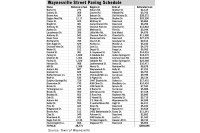Electric rate increase coming for Waynesville

An electric rate study Waynesville Mayor Gavin Brown called “sobering” was presented to the Waynesville Board of Aldermen Oct. 10 and shows shrewd fiscal management on behalf of the town, but an inevitable rate increase on the horizon.
“We’ll probably phase it in in two 6 percent increases, one in January and one in July,” said Rob Hites, Waynesville’s town manager, who noted that the town hasn’t seen a residential rate increase in at least eight years.
“There are not many people anywhere — retail, wholesale — that have held their prices steady for eight years,” Hites said. “It’s kind of overdue.”
Waynesville is one of very few towns in North Carolina called “electric cities” because the town purchases power from a wholesale supplier, and then resells it to customers while carrying out upgrades, repairs, billing, and customer service.
“Any time you talk about electric rates, it’s extremely important to a town,” said Louis Davis, a consultant who spoke on behalf of the consultancy that carried out the electric rate study.
Any “profit” generated from Waynesville’s 3,000 electric customers is more accurately termed a “return on investment,” as that money is deposited into the general fund.
Related Items
Power had been purchased from Duke Energy until recently, when the town switched to South Carolina-based Santee Cooper.
That move alone will likely save the town millions; Duke’s offer to renew the contract at $79.3 million over 10 years — a figure that assumes Duke will be allowed to pass coal ash cleanup costs to consumers, as they’ve demanded — was far above Santee Cooper’s $54.1 million offer.
“While we will have incredible savings, the rate we negotiated with Santee Cooper is still 8 percent higher than Duke’s,” Hites said.
And for good reason — last year, rather than pass along a rate increase to customers, the town simply absorbed more than $200,000 in losses in the electric fund.
The town can’t continue to operate the fund — which grossed $9.41 million last year — at a loss but there really aren’t any other viable ways to cut costs.
Almost 90 percent of that $9.41 million is spent on purchasing wholesale power from Santee Cooper at the rates outlined in the contract.
“Only 12 percent of that budget is for staff, supplies, maintenance, automobiles, gas or whatever,” Hites said. “If you say ‘I want to cut this 12 percent rate increase down to 2 percent, or not have one at all,’ I’ve only got 6 employees. That’s two crews of three. So if you get rid of half your employees, in an outage you don’t have enough people to keep the system going when we have a storm. And if they don’t have any wire, or any transformers, they don’t have any supplies to put up in a storm.”
The proposed rate increase must be approved by aldermen before it takes effect, but consumers will have just a little bit more time to prepare. Brown wants the full board to be present for the vote, but due to upcoming scheduled absences by aldermen Julia Boyd Freeman and Gary Caldwell it probably won’t even be heard until sometime in December.
The proposed increase also compares very favorably to proposals put forth by Duke, which is asking its customers for up to 16.9 percent more each month; that increase would generate over $475 million in revenue, including $300 million for costs related to management and closure of coal ash pits.
The North Carolina Utilities Commission is currently in the public hearing process surrounding the proposed Duke increase, and will not likely rule on it before January.









